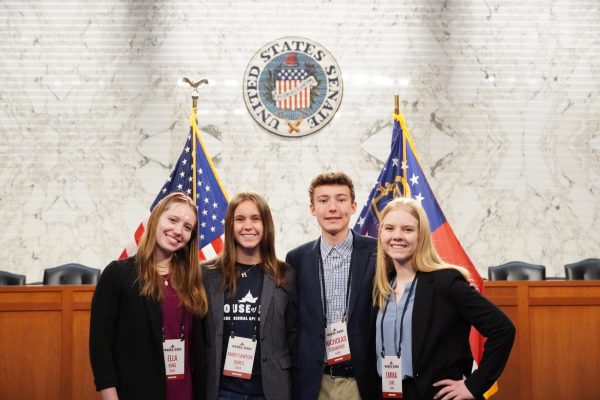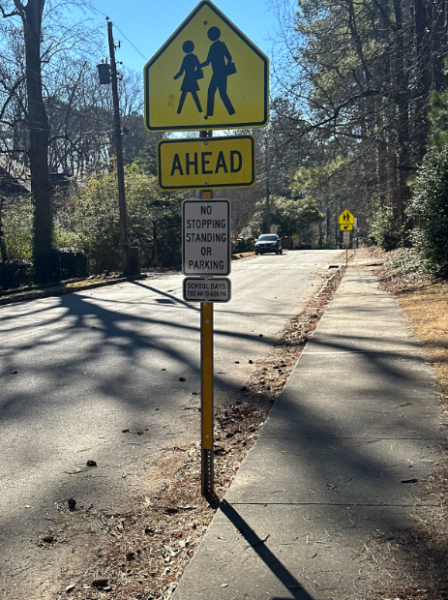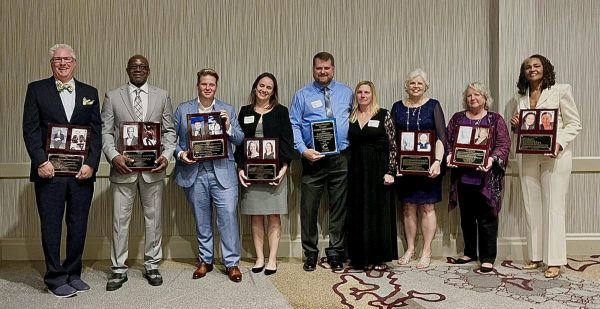Scholastic Gold and Silver Keys Unlock Chamblee Students’ Creativity

“Leave Me Alone!” by Selma Uddin (’22)
This article was debuted in the March 2022 Music & Arts Print Edition.
Recently, the creative students of Chamblee High school took to the 2022 Scholastic Art and Writing Awards Program to show off their best works in hopes of a scholarship and some good old recognition.
Thousands of students from across the country apply to this competition every year that brags itself as “the nation’s longest running, most prestigious recognition program for creative teens.” Scholastic brags notable competition alumni such as Andy Warhol, Sylvia Plath, Robert Redford, Ken Burns, Stephen King, and Amanda Gorman, who spoke at President Joe Biden’s 2021 inauguration.
Talented artists or writers are honored with either a gold key, the highest recognition award, or a silver key, the second-highest level of honor. After awards are distributed between the winners, the gold and silver key winners are invited to an invitation-only formal awards ceremony. Along with numerous gold and silver keys, over 25 honorable mentions were given to pieces of art or writing originating from Chamblee students.
Art Awards- Gold Key Winners
Sarah Duong (‘22)
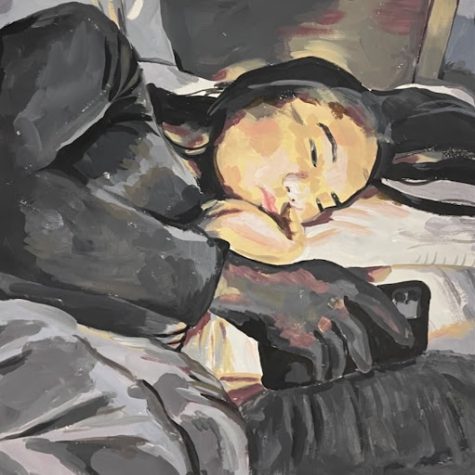
“My AP art portfolio is about mental health and depression specifically. It was about phone addiction,” said Duong when asked to describe her award winning painting.
Duong is part of Chamblee’s AP art classes, which require a central theme that all their work will center around throughout the school year. This piece in particular was centered around the true effects of social media on today’s youth.
“People lose interest in their actual hobbies and to distract from the thoughts they go for the stimulation from your phone screen and social media,” said Duong.
Duong learned about the competition through her art class, and submitted the painting as part of a class assignment.
Using color, or the absence thereof, Doung hoped to reflect a certain mood in the piece, which was created on Bristol paper with acrylic paint.
“I wanted a cool tone to set a certain depressing tone for the mood, but then I wanted the light of the phone to be yellow,” said Duong.
Sydney Grove (‘24)

In Groves winning photo “Teenage Dream”, she captured a memory deep to her.
“I was hanging out with my friends and as I was taking these pictures, I realized, ‘Hey, I’m living up to some of the stuff that I was excited about when I was a little kid.’ I thought that was just so nice,” said Grove.
Along with the other winners, Sydney tied nostalgia and past memories into her piece.
“It kind of channels like the essence of what I wanted to be when I was a little kid. […] I just think it’s nice to highlight the good moments,” said Grove.
“I was just hanging out with my friends one day and on their way over, I was thinking, you know, this is what I always thought of as a kid, like […] you always think about being a teenager, you always look forward to it,” continued Grove. “[What] I was really excited about was just like hanging out with my friends, watching movies, and chilling out doing makeup.”
Her photo submissions included Sadie Schroeder, Tiller Johnson, and Olivia Grove as subjects.
Natalie Brown (‘22)
“My portfolio is kind of based on memories and nostalgia and how those things warp our self image and how we see ourselves now,” said Brown.
With inspirations such as Joe Greer, Wes Anderson, and Barbara Kruger, Brown took much inspiration from them when editing.
“So I do a lot of vintage editing, but sort of like, I want people to feel nostalgia with my work. So a lot of my work that I spent was kind of along those lines,” said Brown.

Brown took to photography at an early age.
“I’ve never really been into drawing or painting, I’m not patient enough to work on a finished piece. I just don’t have the patience that a lot of artists do to paint,” said Brown, “So it was a way that I could express myself without having to write it down or tell people directly.”
Though not many of her pictures that were chosen for Gold keys were thoughtful ones.
“So one of the pieces was this landscape of people walking dogs on the beach. So there’s not really any meaning behind it necessarily that I was just like, they’re snapping a photo, but I like the beach and I like dogs so I guess it ended up working out well,” said Brown.
Brown didn’t put much thought into her photographs, she simply saw something in her head and captured it.
“Then another one was just a picture of my sister in New York. So I don’t know if there was really anything deep behind my pieces per se. Like the pieces that didn’t win were the ones that I actually had deep thought behind them,” said Brown.
Mayla Meekins (‘22)
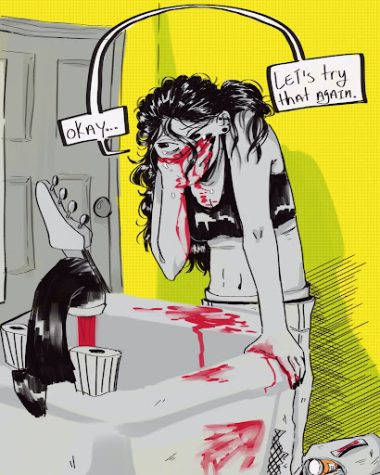
In her piece, Meekins used a more conventional medium of digital art.
“I find digital art a lot easier. In traditional art. I don’t like traditional art that much. And it’s just fun to experiment with the colors and stuff like that. And I use the pink because I didn’t have any fancy origins,” said Meekins.
In the piece, the colors are pretty noticeable.
“I knew I wanted the background to stick out the most instead of the actual subjects like it’s supposed to be an eyesore,” said Meekins.
Meekins wished to create a more unsettling feeling with the piece.
“I really wanted the background to get like a nauseating feeling like yellow, like this bright, ugly yellow,” said Meekins.
Throughout the piece, Meekins connected past experiences.
“I’ve been spending a lot of time in the bathroom, just looking in the mirror and leaning on the sink and I guess it’s just one of the eerie things that inspired the piece,” said Meekins.
Silver Key Winners
Liliana Sandfort (‘24)
“For my piece, I wanted to do an Art Nouveau style. So I took a lot of inspiration from that,” said Sandfort.
Liliana took a more unique approach in her winning piece.
I used the style Art Nouveau which is a style characterized by a lot of natural elements of nature. And I also put myself in the art piece,” said Sandfort.
In Sandfort’s piece, she used a unique medium.
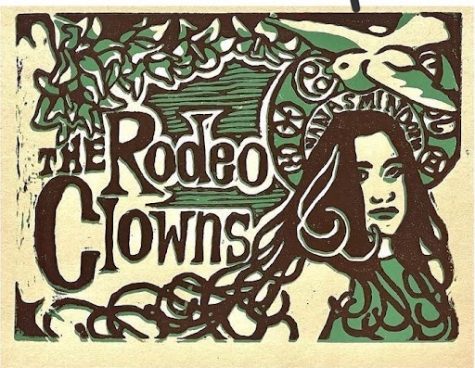
“I used linoleum block printing with water soluble ink, I really like printing with it and the linoleum was nice and hard so I created more detail,” said Sandfort.
But using linoleum comes with an extensive process.
First, “When using linoleum you have to carve out the negative space so I traced, and then I traced it again to create these indents in the linoleum and carve around the lines,” said Sandfort.
Second, it needs to be inked and put on paper.
Though the last step is crucial in creating detail and dimension.
“I carve out the second layer and then I ink it again with a different color and it lets the color underneath show,” said Sandfort.
Though using this medium comes with its own set of challenges.
“The ink is really hard to manage. It’s really hard to get consistent prints and the linoleum. It’s hard to control your cuts and get detail,” said Sandfort.
But by using linoleum, Sandfort was able to reflect the theme of nature in the piece with the combination of greens and browns when printing.
Selma Uddin (‘22)
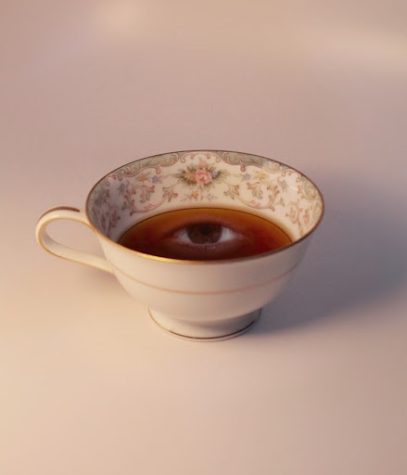
“My portfolio for AP is kind of focusing around emotions and how that relates to how it may be perceived as fragility on the outside,” said Uddin.
Uddin tends to take a more creepy direction in editing.
“Basically I draw a lot of inspiration from the other kinds of media I consume. I think I tend to prefer artists/photographers who have creepier/less-traditional styles, so that kinda shows up in my own work. I love horror movies and I get a lot of inspiration from them, so that definitely contributes as well,” said Uddin.
Editing allows Uddin to be set free in the realm of imagination.
“With photography, it’s hard because you have to use real stuff versus like painting, you get to kind of whatever your imagination creates, you get to create. So with editing, I feel like I get to explore some of the other things that I can’t create physically,” said Uddin.
Bryan Zhao (‘23)
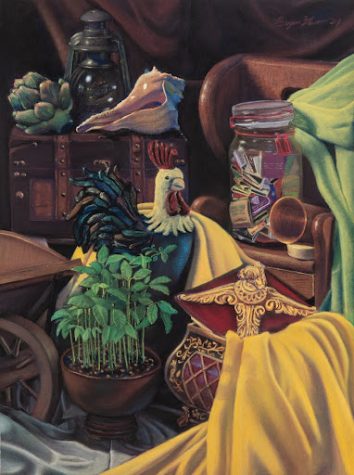
“My work was set up kind of like the old rustic style of the 1900s. It was really interesting. And it kind of reminded me of my parents’ childhood,” said Zhao.
In order to paint this intricate piece, Zhao had to go through a specific process.
“I set up a still life to do it. So I just looked at the values. And then I also use color theory, which, basically using opposing colors as complimentary,” said Zhao.
Though this was only possible with the use of chalk pastel and its many pros.
“In my piece I used chalk pastel, you can layer a lot if you have, like, good paper. And it’s pretty forgiving. So like, if you mess up, you can go over it,” said Zhao.
Deanna Sharpe (‘22)
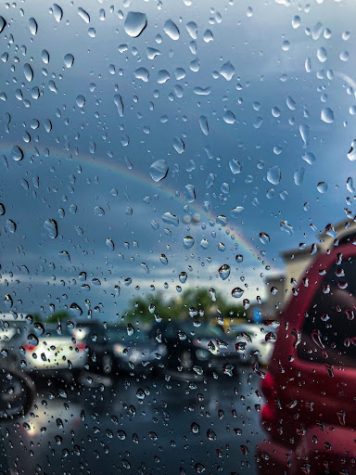
“The first one was really just me at the botanical garden thing. I really liked playing with colors at the time because I was just starting out,” said Sharpe, “I just really liked the fact that it was dark and I managed to make everything really bright or whatever.”
The next piece from Sharpe reflected the universal theme of nostalgia in the contest.
“The other one was because of my grandma. She used to say this to me, rain rain go away. I hated the rain, like I really hated it, but she really wanted me to make some joy out of it. So she made the song,” said Sharpe.
By editing the photos, Sharpe was able to set a solemn mood with “Rain Rain Go Away.”

“Well, for the “Rain Rain Go Away” piece, I wanted to play more with the blue so that way the rainbow itself would pop out,” said Sharpe.
Though Sharpe used an iPhone 6 to capture the pieces, she used editing to make them into the pieces they are today.
“Obviously your photos aren’t going to be as good a quality. So of course it was like issues with getting the color right and everything because one of the pictures was like in the dark. So I had to really work with the sun mode where you can adjust,” said Sharpe.
Sharpe didn’t let the poor quality of the iPhone camera stop her.
“For the “Light Shines in the Darkness” piece, it was more like playing with the lights so that the lights looked good, especially since of course I was disadvantaged with the phone quality,” said Sharpe.
Anne Cooke (‘22)
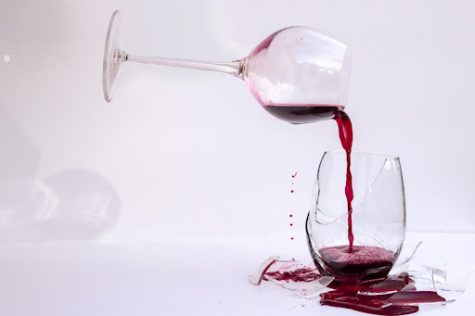
Cooke’s winning photograph, showing a wine glass pouring wine into a broken glass, comes with deep thought.
“It’s all about grief and loss and just sort of like the process of that and how it looks different for everyone,” said Cooke.
Cooke utilizes editing software to shape the image in her vision.
“In order to show an idea you have in your head, you have to actually physically be able to take a picture [so for this piece] you have to do a lot of heavy editing,” said Cooke.
Leonardo Song (‘24)
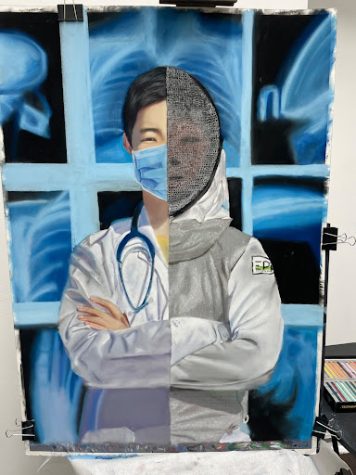
“For this piece, I just thought about what I wanted to do when I grew up,” said Song.
He captured his aspirations in chalk pastels, a more unique medium.
“It shows […] what I want to be and my passion,” described Song.
Song was resourceful in his creation of the piece, using an edited reference image as his starting point.
“I had a photo […] edited with [this] background and I just was inspired by the color of that,” said Song.
Writing Awards – Silver Key
Ashika Srivastava (‘22)
Srivastava, one of the key winners for writing at Chamblee, wrote two poems for the writing competition.
“The first one was about deforestation. I wrote it from the perspective of a tree, and the tree was talking about a relationship with a boy, like personification. But then the tree gets cut down because they were building buildings,” said Srivastava.
Though Srivastava didn’t write only about nature conservation.
“The second poem was different because it was about how the lockdown, like the initial COVID lockdown and how this was a positive thing for the environment since people weren’t leaving their houses, making less air pollution, less water pollution, and littering. The fact that because we were all at home, the environment was just thriving because we weren’t there to pollute it,” said Srivastava.
But why did she pick nature conservatism for Scholastic?
“Conservation is very important and it’s definitely something that is good to convey through writing. Important messages can be conveyed through writing. So I think that this is a topic really close to me that I also want to talk about,” said Srivastava.
Srivastava was passionately driven to write on this topic.
“I think just like seeing the news and what COVID did to everyone kind of drew me to the theme of how has COVID impacted our environment,” said Srivastava.
But where did Srivastava get these passionate opinions?
“I have this one writer, her name is Ruta Sepetys. […] So I think she really inspires me to have a message in my writing and just talk about things that are meaningful through writing,” said Srivastava.
For Srivastava, writing has always been a big part of her life.
“When I was a kid, I would just write random stories about crazy things. As I got older, I just kept writing. It’s just been this constant in my life. It’s very calming for me,” said Srivastava.
Though Srivastava loves writing, poetry isn’t her favorite style.
“Poetry is probably my least favorite type of writing, since it has such a specific structure. You have to rhyme sometimes or you can go really abstract. It’s not like actual writing. The punctuations are all wacky,” said Srivastava.
What’s the submission process like for this contest?
In order to submit a piece to scholastic, there is a fee.
“I mean, I think it was like $7 per submission, which is like, not terrible, but I’m not gonna be sending $7 per submission and it adds up,” said Uddin.
Students can find ways around this fee.
“I wasn’t about to pay $25 [the cost to submit a portfolio], so I just got the fee waived,” said Brown.
The submission process is pretty straightforward, but it is tedious.
“This year I submitted nine. You have to fill out a form for each individual piece and you have to get your parents [involved],” said Brown.
The extensive amounts of forms are one of the main drawbacks of the contest.
“Scholastic is so difficult. You have to submit forms with every submission you do. […] If you submit 10 photos, you have to do each form for each one […] and like a parent consent form,” said Uddin.
How can winners use their awards?
“It can just bring so many opportunities for summer programs, scholarships, stuff like that,” said Grove.
The program can open a lot of doors for winners.
“It’s by SCAD [Savannah College of Art and Design], so you can do something like a summer SCAD program if you win an award,” said Zhao.
Should you apply next year?
The verdict is in…
“Yes, please do that contest. It is great. It is very rewarding. Even if you don’t do anything, it’s fun to pick stuff out and name it, enter your statements for it, explain yourself,” said Grove. “It’s just a great way to channel your art.”
Chamblee students are also known to do quite well.
“Yeah, I would think most people who did it ended up getting some sort of honorable mention or like silver or gold [key]. A lot of gold [keys] actually. I think it’s just fun to try it out and see where you can improve and what you can do,” said Sharpe.
If you would like to apply next year, registration should open in the new school year for the 2023 Scholastic Art and Writing Awards. Don’t be afraid to submit something because it could bring many scholarships and recognition to your creative works!
Your donation will support the student journalists of Chamblee High School Blue & Gold. Your contribution will allow us to print editions of our work and cover our annual website hosting costs. Currently, we are working to fund a Halloween satire edition.
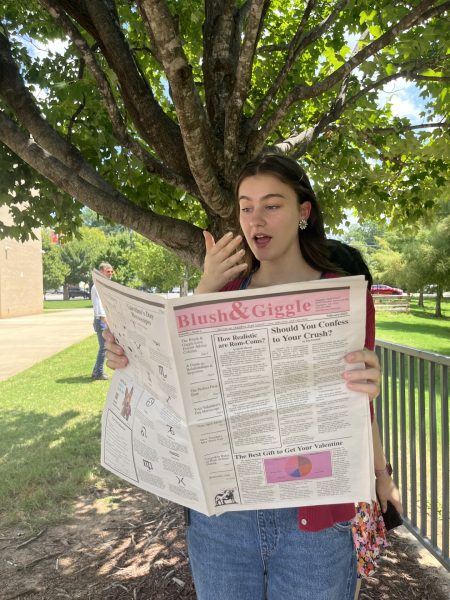
Luiza Douglas ('24) is a senior and the Senior Editor for the Blue & Gold. In five years, she hopes to be living in the big city (wherever it may be), or still in Mr. Avett's class. Her three favorite things are Lana Del Rey, Boston Clogs, and being vegetarian.


